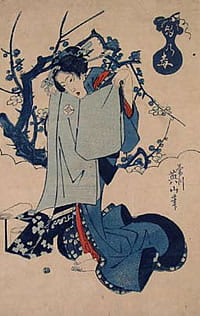Japan in Blue and White
Frank and Toshie Mosher Gallery of Japanese Art
March 25, 2010 – March 6, 2011
In Japan, the pairing of blue and white has resulted in some of the most dramatic and uniquely Japanese designs. Indigo blue dye has been used to embellish textiles for centuries, while the mineral cobalt oxide has been used since the 17th century as an underglaze pigment on ceramics. In the early 19th century, a third blue pigment, Prussian blue, was imported from Europe and was so popular that it gave rise to a type of woodblock print known as aizuri-e, or “pictures printed in blue.” These three blue pigments were originally employed for practical reasons – indigo dye repelled mosquitoes, cobalt oxide is one of the most stable underglaze ceramic pigments, and Prussian blue was colorfast. Mainly drawn from the Museum’s collection, the exhibition will focus on blue and white ceramics, textiles and woodblock prints to illustrate the history of three blue pigments and their development in Japan.
Guest-curated by Meher McArthur
This exhibition was made possible by Setsuko Oka in honor of Grace Oka Latham.
Related Programs:
Curator’s Tour
Saturday, April 17, 2010, 11am
Explore the science and art of color in Japan in Blue and White with Meher McArthur
Reception
Friday, May 7, 2010
Members at the Chrysanthemum level and above enjoy a celebration of Japan in Blue and White
